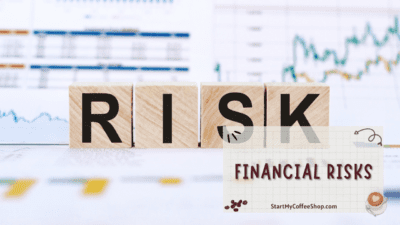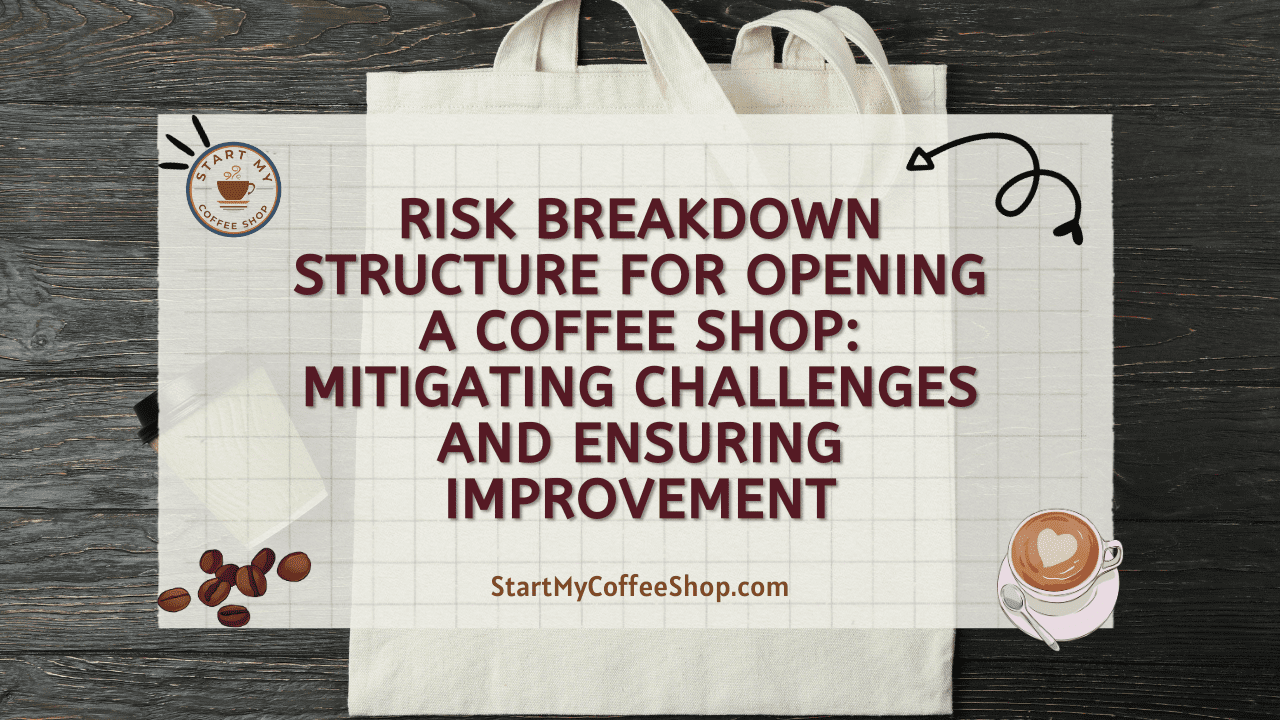Opening a coffee shop can be an exciting venture, providing a space for people to gather, sip on their favorite brews, and enjoy a cozy ambiance. However, like any business endeavor, it comes with its fair share of risks and challenges. To navigate these potential pitfalls effectively, it is crucial to develop a comprehensive Risk Breakdown Structure (RBS).
A Risk Breakdown Structure (RBS) helps identify and categorize potential risks, such as market saturation, operational challenges, financial uncertainties, regulatory compliance, and reputation risks. Coffee shop owners can navigate uncertainties and increase their chances of progress by having a strong RBS.
In this article, I will explore the key components of an RBS for opening a coffee shop, identify common risks, and provide practical strategies for mitigating them.
Defining a Risk Breakdown Structure (RBS)
A risk breakdown structure (RBS) is an invaluable tool for managing potential risks in a project or venture, such as opening a coffee shop. It offers a systematic approach to identifying and categorizing these risks, allowing stakeholders to gain a comprehensive understanding of the project’s vulnerabilities. By providing a roadmap for recognizing and addressing risks at various levels, the RBS assists in developing effective risk mitigation strategies.

Opening a coffee shop involves numerous potential risks, ranging from financial uncertainties to operational challenges and customer-related issues. The RBS acts as a framework to organize these risks into categories and subcategories, facilitating a more focused analysis.
For example, financial risks might include securing sufficient funding, managing cash flow, and forecasting sales accurately. Operational risks could encompass procuring equipment, hiring and training staff, and ensuring a smooth supply chain. Customer-related risks might involve understanding and meeting customer preferences, managing customer complaints, and maintaining a loyal customer base.
The RBS enables stakeholders to visualize the risks associated with the coffee shop venture at different levels, starting from the broader categories and drilling down to more specific risks.
This breakdown enhances risk identification, ensuring that no crucial risks are overlooked. Additionally, the RBS encourages collaboration among stakeholders, enabling them to collectively assess risks and develop appropriate mitigation strategies.
Once potential risks are identified and categorized using the RBS, stakeholders can prioritize them based on their potential impact and likelihood of occurrence. This prioritization allows for a more efficient allocation of resources and efforts toward mitigating the most critical risks.
Stakeholders can then develop risk mitigation strategies tailored to each identified risk, implementing preventive measures, contingency plans, and monitoring mechanisms.
Read more about: How to Open Your Own Coffee Shop: From Beans to Brew
Identifying and Categorizing Risks
To create an effective RBS, it is essential to identify and categorize risks specific to opening a coffee shop. Here are some common risk categories to consider:
Market Risks
Market risks pose significant challenges for any business, including a coffee shop venture. These risks encompass various factors that can impact market dynamics and customer behavior.
The following market risks should be considered and addressed when opening a coffee shop:
- Competitor saturation and market demand fluctuations are primary concerns for a coffee shop. The presence of numerous competitors in the area can lead to intense competition for customers. It is crucial to assess the market saturation and determine if there is sufficient demand to sustain the coffee shop’s operations. Additionally, market demand can fluctuate due to factors such as seasonal variations, economic conditions, or changes in customer preferences.
- Changes in consumer preferences and trends can significantly impact the performance of a coffee shop. It is important to stay attuned to evolving consumer tastes, preferences, and trends in the coffee industry.
Failure to adapt to changing consumer demands may result in a decline in customer base and revenue. Regularly monitoring and analyzing customer feedback, conducting surveys, and keeping up with industry trends can help mitigate this risk.
- Location selection and target market misalignment can be significant market risks. Choosing the right location is crucial to attract the desired customer base. Factors such as foot traffic, proximity to residential and commercial areas, and the presence of competitors should be considered.
Understanding the target market is vital to tailor the coffee shop’s offerings and ambiance to meet their needs and preferences. Misalignment between the chosen location and the target market can result in lower customer traffic and reduced sales.
Operational Risks
Operational risks play a crucial role in the solid functioning of a coffee shop. These risks pertain to the day-to-day operations and internal processes that drive the business. The following operational risks should be carefully considered and managed when opening a coffee shop:
- Equipment breakdown or failure is a significant operational risk. Coffee shops heavily rely on equipment such as coffee machines, grinders, and refrigeration units. Any malfunction or breakdown can disrupt operations, leading to delays, dissatisfied customers, and potential revenue loss. To mitigate this risk, regular equipment maintenance and servicing are essential.
- Supply chain disruptions can have a severe impact on a coffee shop’s operations. These disruptions can occur due to various reasons, such as delays in the delivery of coffee beans, milk, or other ingredients, or issues with suppliers. Such disruptions can result in inventory shortages, affecting the availability of menu items and customer satisfaction.
- Staffing challenges and turnover pose operational risks in the coffee shop industry. Finding and retaining skilled and reliable staff can be a continual challenge. Staff turnover can disrupt operations, affect service quality, and increase training and recruitment costs.
Financial Risks
Financial risks are critical considerations when opening a coffee shop, as they directly impact the business’s sustainability and profitability. The following financial risks should be carefully managed and mitigated:

- Insufficient capital or cash flow issues pose significant financial risks. Starting a coffee shop requires adequate initial capital to cover expenses such as rent, equipment purchases, renovations, inventory, and staffing. Insufficient capital can hinder the smooth operations of the business and limit its ability to seize growth opportunities. Cash flow issues, including delays in customer payments or unexpected expenses, can also disrupt the financial stability of the coffee shop.
- Unexpected cost escalation is another financial risk that coffee shop owners need to be prepared for. Construction or renovation costs, equipment repairs, and ongoing operational expenses can exceed initial estimates, impacting the business’s profitability.
- Inaccurate sales forecasts and profit margins can significantly impact the financial health of a coffee shop. Overestimating sales or underestimating expenses can result in lower-than-expected profits or even losses.
Read more about: How to Open a Coffee Shop Business Plan: Espresso to Entrepreneurship
Regulatory Risks
Regulatory risks are a crucial consideration when opening a coffee shop, as non-compliance with regulations can lead to legal consequences, reputational damage, and operational disruptions. The following regulatory risks should be carefully managed and addressed:
- Compliance with health and safety regulations is of utmost importance in the food and beverage industry, including coffee shops. Ensuring a safe and hygienic environment for customers and employees is essential. This involves complying with regulations related to food handling, storage, preparation, and sanitation.
- Licensing and permit requirements are critical regulatory risks for coffee shops. Operating a food establishment typically requires obtaining and maintaining various licenses and permits, such as business licenses, food handling permits, and liquor licenses if applicable. Failure to secure or renew these licenses and permits can result in fines, closure orders, or even legal actions.
- Food and beverage quality control is essential to meet regulatory standards and maintain customer satisfaction. Coffee shops must adhere to regulations related to food quality, labeling, allergen information, and product safety.
Reputation Risks
Reputation risks are critical considerations for a coffee shop, as they directly impact customer perception, loyalty, and overall business impact. The following reputation risks should be carefully managed and addressed:
- Negative customer experiences and reviews pose a significant reputation risk for a coffee shop. Unsatisfactory service, poor quality products, or issues with cleanliness can lead to negative customer experiences and negative online reviews. In today’s digital age, where online reviews and ratings hold considerable influence, a single negative review can impact the reputation of the coffee shop and deter potential customers.
- Branding and marketing missteps can also result in reputation risks. Inconsistent branding, misleading advertising, or offensive marketing campaigns can damage the coffee shop’s reputation and erode customer trust.
- Social media backlash is a reputation risk that has become increasingly prevalent in recent years. Negative comments, criticisms, or viral incidents shared on social media platforms can quickly spread and harm the coffee shop’s reputation.
Creating the Risk Breakdown Structure
Once the risks associated with opening a coffee shop have been identified and categorized, it is important to create a risk breakdown structure (RBS) to effectively manage and mitigate those risks.
The RBS provides a systematic and hierarchical approach to understanding the relationship between different risk elements, allowing stakeholders to gain a comprehensive understanding of potential challenges and develop targeted risk mitigation strategies.

The RBS typically consists of multiple levels, starting with high-level risk categories and progressively drilling down into more specific risks. At the highest level, the RBS may include broad categories such as market risks, operational risks, financial risks, regulatory risks, and reputation risks. These categories serve as the foundation for further analysis and exploration.
Within each category, more specific risks are identified and categorized. For example, under market risks, subcategories such as competitor saturation and market demand fluctuations, changes in consumer preferences and trends, and location selection and target market misalignment may be included.
Similarly, operational risks may include subcategories such as equipment breakdown or failure, supply chain disruptions, staffing challenges, and turnover. Each subcategory is further broken down into specific risks that are relevant to the coffee shop venture.
By breaking down risks into hierarchical levels, the RBS provides a structured framework for understanding and addressing potential challenges. It allows stakeholders to prioritize risks based on their significance and potential impact on the project.
The RBS helps stakeholders gain a clear overview of the vulnerabilities and potential areas of concern, enabling them to allocate resources and develop targeted risk mitigation strategies.
The RBS also facilitates communication and collaboration among project stakeholders. It provides a common language and framework for discussing and addressing risks.
The hierarchical structure allows for better organization and presentation of risk information, making it easier to communicate and share insights with team members, investors, and other stakeholders.
Read more about: How to Make Business Plan for Coffee Shop: From Beans to Brew
Assessing and Prioritizing Risks
Once the risk breakdown structure (RBS) has been established for the coffee shop venture, the next step is to assess and prioritize the identified risks. This assessment involves evaluating each risk based on its likelihood of occurrence and the potential impact it may have on the improvement of the coffee shop.
Assigning a risk score to each element helps in determining the priority of risks and enables effective resource allocation. The risk score can be calculated by multiplying the likelihood of occurrence (e.g., low, medium, high) by the potential impact (e.g., low, medium, high) associated with each risk. This scoring system allows you to focus your attention and resources on mitigating high-priority risks while developing contingency plans for lower-priority risks.
High-priority risks with a high likelihood of occurrence and significant potential impact demand immediate attention and require proactive risk mitigation strategies.
These risks pose a direct threat to the growth of the coffee shop and should be addressed promptly. Mitigation efforts may involve implementing preventive measures, allocating additional resources, or developing alternative plans to minimize their impact.
Medium-priority risks, while not as critical as high-priority risks, still require attention and mitigation. These risks may have a moderate likelihood of occurrence and a moderate potential impact.
Mitigation strategies for medium-priority risks may include developing contingency plans, conducting regular monitoring and assessments, and allocating resources to address them if they arise.
Low-priority risks, with a low likelihood of occurrence and minimal potential impact, may not require immediate action but should not be ignored entirely.
These risks can still affect the coffee shop’s operations and profitability if they materialize. It is advisable to have a plan in place to address such risks, even if they are less likely to occur.
Regular review and reassessment of the identified risks are essential throughout the coffee shop venture. As circumstances change and new risks emerge, the risk assessment should be updated to ensure that mitigation efforts remain relevant and effective.
Developing Risk Mitigation Strategies
Mitigating risks effectively requires a proactive approach. Here are some strategies to consider for each risk category:
Market Risks
To mitigate market risks when opening a coffee shop, it is crucial to conduct thorough market research and competitor analysis. This helps in understanding the local market landscape, customer preferences, and competitor offerings, enabling informed decision-making.
Adapting to changing consumer preferences is essential by offering diverse products, such as specialty coffee and alternative milk options. Additionally, carefully selecting a location based on foot traffic and the target demographic ensures optimal visibility and customer reach.
Operational Risks

To mitigate operational risks when opening a coffee shop, several strategies can be implemented. Regular equipment maintenance and having backup plans in place ensure that any potential breakdowns or failures do not disrupt the operations.
Establishing strong relationships with suppliers and having alternative options available helps in mitigating supply chain disruptions. Implementing effective staff training programs and retention initiatives ensures a skilled and motivated workforce, reducing staffing challenges and turnover.
By implementing these strategies, coffee shop owners can minimize operational risks, maintain smooth operations, and deliver a consistent and high-quality experience to customers.
Read more about: How to Make a Coffee Shop Business Plan: Fueling Your Entrepreneurial Spirit
Financial Risks
To mitigate the financial risks associated with opening a coffee shop, several measures can be taken. Creating a comprehensive business plan with accurate financial projections helps in understanding the financial requirements and potential challenges.
Maintaining a contingency fund for unexpected expenses provides a safety net to handle unforeseen circumstances. Developing strong relationships with financial institutions and exploring potential funding sources ensure access to capital and financial support when needed.
By implementing these strategies, coffee shop owners can minimize financial risks, maintain financial stability, and improve the chances of long-term growth.
Regulatory Risks
To mitigate regulatory risks when opening a coffee shop, it is crucial to stay updated with local health and safety regulations. This includes understanding requirements related to food handling, sanitation, and workplace safety.
Seeking professional advice from experts in the field can ensure compliance with the necessary regulations and avoid potential legal issues. Implementing rigorous quality control measures, such as regular inspections and testing, helps maintain compliance with food and beverage quality standards.
By implementing these strategies, coffee shop owners can mitigate regulatory risks, operate within legal boundaries, and provide a safe and high-quality experience for customers.
Reputation Risks
To mitigate reputation risks for a coffee shop, certain strategies can be implemented. Prioritizing excellent customer service and addressing any complaints promptly and effectively helps in maintaining a positive reputation. Building a strong brand identity through consistent messaging and branding across all touchpoints creates a recognizable and trusted image.
Engaging with customers on social media platforms and responding to their feedback proactively demonstrates attentiveness and care. By implementing these strategies, coffee shop owners can mitigate reputation risks, build a positive brand image, and foster customer loyalty, leading to long-term growth and a positive perception of the market.
Monitoring and Reviewing the RBS
The risk breakdown structure (RBS) is not a static document but a dynamic tool that requires ongoing monitoring and review. As your coffee shop evolves and operates in a dynamic business environment, new risks may emerge, while existing risks may change in significance.
Therefore, it is crucial to periodically revisit and update the RBS to ensure its continued relevance and effectiveness in mitigating risks.
Regular monitoring of the business operations and external factors that can impact the coffee shop is essential. This includes staying updated on market trends, competitor activities, regulatory changes, and customer preferences. By continuously monitoring these factors, you can identify new risks that may arise and assess their potential impact on the business.
Additionally, ongoing evaluation of existing risks is necessary. The significance of certain risks may change over time due to various factors such as market conditions, operational changes, or shifts in consumer behavior. By reassessing the identified risks, you can determine if any adjustments need to be made in terms of priority, mitigation strategies, or resource allocation.
/
The RBS should be reviewed and updated in collaboration with relevant stakeholders, such as management, employees, and external advisors. Their input and insights can provide valuable perspectives on the current risks and help identify any blind spots that may have been overlooked.
Updating the RBS may involve adding new risk categories or refining existing ones to capture the evolving landscape. It may also entail modifying risk mitigation strategies, implementing additional controls, or allocating resources differently to address the changing risks effectively.
Frequently Asked Questions

Question: Why is a risk breakdown structure important for opening a coffee shop?
Answer: A risk breakdown structure helps identify and categorize potential risks, allowing coffee shop owners to proactively address challenges, develop mitigation strategies, and increase the likelihood of achievement.
Question: How do I identify risks specific to opening a coffee shop?
Answer: Conduct thorough market research, analyze competitor saturation, consider operational challenges, evaluate financial uncertainties, review regulatory requirements, and anticipate reputation risks to identify potential risks.
Question: How can I prioritize risks in my risk breakdown structure?
Answer: Assess risks based on their likelihood of occurrence and potential impact on the coffee shop’s progress. Assign risk scores to prioritize high-priority risks and allocate resources accordingly.
To learn more on how to start your own coffee shop, check out my startup documents here.
Disclaimer: The information provided by StartMyCoffeeShop.com (“The Site”) is for general informational purposes only. All information on the Site is provided in good faith. However, we make no representation or warranty of any kind, express or implied, regarding the accuracy, adequacy, validity, reliability, availability, or completeness of any information on the Site. Under no circumstance shall we have any liability to you for any loss or damage of any kind incurred as a result of the use of the Site or Reliance on any information provided on the Site. Your use of the Site and reliance on any information on the Site is solely at your own risk. This blog post is for educational purposes only and does not constitute legal advice. Please consult a legal expert to address your specific needs. Terms and Conditions. (https://startmycoffeeshop.com/terms-and-conditions/)

Hi! I’m Shawn Chun
My adventure in coffee began when I first launched my first coffee shop back in the early 2000s. I had to figure out so many things on my own and to make it worse within 2 years of opening two large corporate coffee chains moved in just blocks away from me!
As I saw smaller and even some larger coffee shops in the neighborhood slowly lose customers to these giant coffee chains and slowly close up shop, I knew that I had to start getting creative…or go out of business.
I (like you may be) knew the coffee industry well. I could make the best latte art around and the foam on my caps was the fluffiest you have ever seen. I even had the best state-of-the-art 2 group digital Nuova Simonelli machine money could buy. But I knew that these things alone would not be enough to lure customers away from the name brand established coffee shops.
Eventually, through lots of trial and error as well as perseverance and creativity I did find a way to not only survive but also thrive in the coffee/espresso industry even while those corporate coffee chains stayed put. During those years I learned to adapt and always faced new challenges. It was not always easy, however, in the end, I was the sole survivor independent coffee shop within a 10-mile radius of my location. Just two corporate coffee chains and I were left after that year. All told the corporate coffee chains took down over 15 small independent coffee shops and kiosks and I was the last one standing and thriving.
Along the years I meet others with the same passion for coffee and I quickly learned that it is not only “how good a barista is” that makes a coffee shop successful, but the business side of coffee as well.
Hence why I started this website you are on now. To provide the tools and resources for up and coming coffee shop owners to gain that vital insight and knowledge on how to start a coffee shop successfully.
Stick around, browse through my helpful blog and resources and enjoy your stay! With lots of LATTE LOVE!
Shawn







